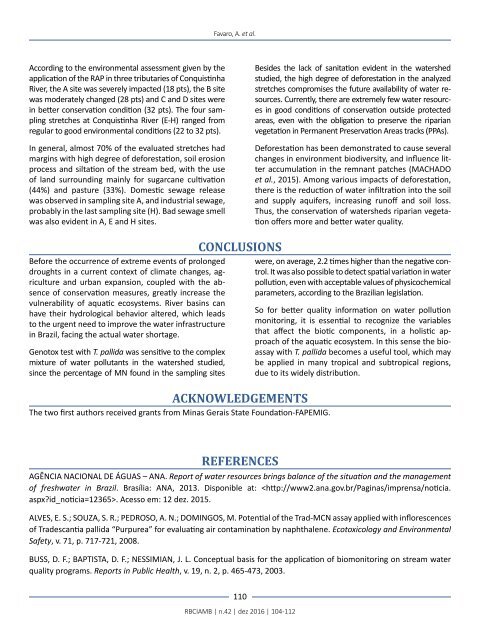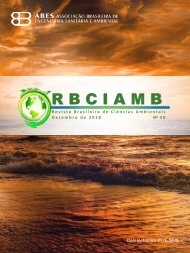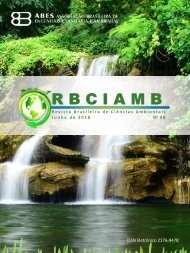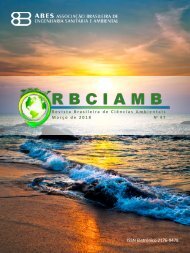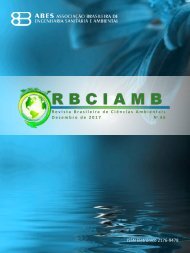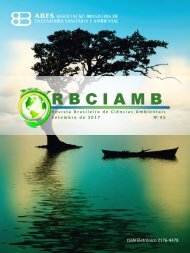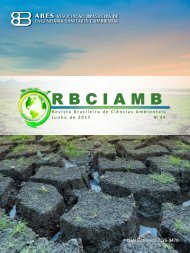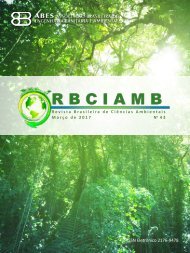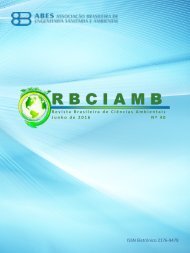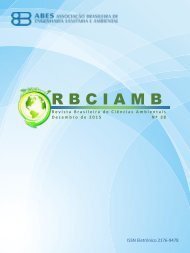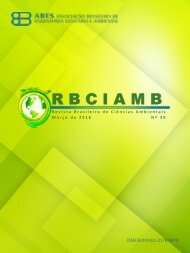EDIÇÃO 42 RBCIAMB
Create successful ePaper yourself
Turn your PDF publications into a flip-book with our unique Google optimized e-Paper software.
Favaro, A. et al.<br />
According to the environmental assessment given by the<br />
application of the RAP in three tributaries of Conquistinha<br />
River, the A site was severely impacted (18 pts), the B site<br />
was moderately changed (28 pts) and C and D sites were<br />
in better conservation condition (32 pts). The four sampling<br />
stretches at Conquistinha River (E‐H) ranged from<br />
regular to good environmental conditions (22 to 32 pts).<br />
In general, almost 70% of the evaluated stretches had<br />
margins with high degree of deforestation, soil erosion<br />
process and siltation of the stream bed, with the use<br />
of land surrounding mainly for sugarcane cultivation<br />
(44%) and pasture (33%). Domestic sewage release<br />
was observed in sampling site A, and industrial sewage,<br />
probably in the last sampling site (H). Bad sewage smell<br />
was also evident in A, E and H sites.<br />
Besides the lack of sanitation evident in the watershed<br />
studied, the high degree of deforestation in the analyzed<br />
stretches compromises the future availability of water resources.<br />
Currently, there are extremely few water resources<br />
in good conditions of conservation outside protected<br />
areas, even with the obligation to preserve the riparian<br />
vegetation in Permanent Preservation Areas tracks (PPAs).<br />
Deforestation has been demonstrated to cause several<br />
changes in environment biodiversity, and influence litter<br />
accumulation in the remnant patches (MACHADO<br />
et al., 2015). Among various impacts of deforestation,<br />
there is the reduction of water infiltration into the soil<br />
and supply aquifers, increasing runoff and soil loss.<br />
Thus, the conservation of watersheds riparian vegetation<br />
offers more and better water quality.<br />
Before the occurrence of extreme events of prolonged<br />
droughts in a current context of climate changes, agriculture<br />
and urban expansion, coupled with the absence<br />
of conservation measures, greatly increase the<br />
vulnerability of aquatic ecosystems. River basins can<br />
have their hydrological behavior altered, which leads<br />
to the urgent need to improve the water infrastructure<br />
in Brazil, facing the actual water shortage.<br />
Genotox test with T. pallida was sensitive to the complex<br />
mixture of water pollutants in the watershed studied,<br />
since the percentage of MN found in the sampling sites<br />
CONCLUSIONS<br />
ACKNOWLEDGEMENTS<br />
The two first authors received grants from Minas Gerais State Foundation‐FAPEMIG.<br />
were, on average, 2.2 times higher than the negative control.<br />
It was also possible to detect spatial variation in water<br />
pollution, even with acceptable values of physicochemical<br />
parameters, according to the Brazilian legislation.<br />
So for better quality information on water pollution<br />
monitoring, it is essential to recognize the variables<br />
that affect the biotic components, in a holistic approach<br />
of the aquatic ecosystem. In this sense the bioassay<br />
with T. pallida becomes a useful tool, which may<br />
be applied in many tropical and subtropical regions,<br />
due to its widely distribution.<br />
REFERENCES<br />
AGÊNCIA NACIONAL DE ÁGUAS – ANA. Report of water resources brings balance of the situation and the management<br />
of freshwater in Brazil. Brasília: ANA, 2013. Disponible at: . Acesso em: 12 dez. 2015.<br />
ALVES, E. S.; SOUZA, S. R.; PEDROSO, A. N.; DOMINGOS, M. Potential of the Trad‐MCN assay applied with inflorescences<br />
of Tradescantia pallida “Purpurea” for evaluating air contamination by naphthalene. Ecotoxicology and Environmental<br />
Safety, v. 71, p. 717‐721, 2008.<br />
BUSS, D. F.; BAPTISTA, D. F.; NESSIMIAN, J. L. Conceptual basis for the application of biomonitoring on stream water<br />
quality programs. Reports in Public Health, v. 19, n. 2, p. 465‐473, 2003.<br />
110<br />
<strong>RBCIAMB</strong> | n.<strong>42</strong> | dez 2016 | 104-112


